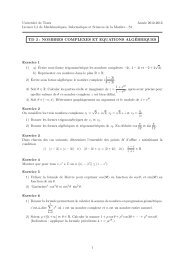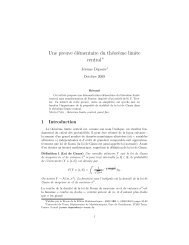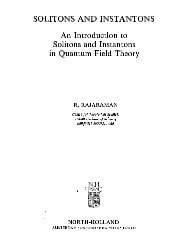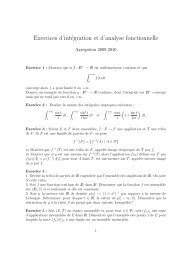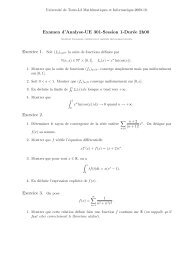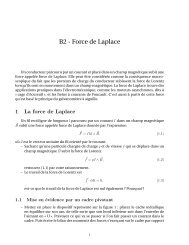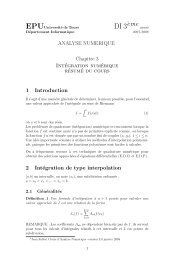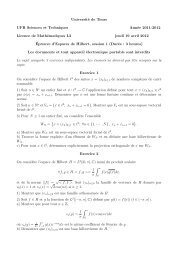Magnetic susceptibility of the two-dimensional Ising model ... - LMPT
Magnetic susceptibility of the two-dimensional Ising model ... - LMPT
Magnetic susceptibility of the two-dimensional Ising model ... - LMPT
You also want an ePaper? Increase the reach of your titles
YUMPU automatically turns print PDFs into web optimized ePapers that Google loves.
a 1 (y) = 1 3<br />
a 2 (y) = 2 3<br />
a 3 (y) = 1<br />
64<br />
×<br />
sinh γ(0)+γ(2π/3) sinh γ(π)+γ(2π/3) sinh 2 γ(2π/3)+γ(π/3)<br />
2 2 2<br />
sinh γ(0)+γ(π/3) sinh γ(π)+γ(π/3) sinh γ(π/3) sinh γ(2π/3) , (3.13)<br />
2 2<br />
sinh γ(0)+γ(π/3) sinh γ(0)+γ(π)<br />
2 2<br />
cos(2πy/3), (3.14)<br />
sinh γ(π/3) sinh γ(π/3)+γ(π)<br />
2<br />
1<br />
sinh γ(0)+γ(π/3) sinh γ(π)+γ(π/3) sinh γ(0)+γ(2π/3) sinh γ(π)+γ(2π/3)<br />
2 2 2 2<br />
1<br />
sinh γ(π/3) sinh γ(2π/3) sinh 2 γ(π/3)+γ(2π/3)<br />
2<br />
.<br />
× (3.15)<br />
The transfer matrix 2 3 × 2 3 has 8 eigenvalues, some <strong>of</strong> <strong>the</strong>m are equal. Besides that,<br />
some eigenvectors have zero components. As result, <strong>the</strong> expression for <strong>the</strong> correlation<br />
function (3.3) contains only three (not seven) independent terms. If we take into account<br />
<strong>the</strong> definition (2.11), (2.12) <strong>of</strong> <strong>the</strong> function γ(q) for particular values <strong>of</strong> quasimomentum<br />
q = 0, π/3, 2π/3, π , we get exact correspondence between this three terms and (3.10)–<br />
(3.15).<br />
4 Momentum representation <strong>of</strong> <strong>the</strong> correlation<br />
function<br />
Since we have <strong>the</strong> expression (3.2) for g n (r), which depends on both components <strong>of</strong> r , we<br />
can make <strong>the</strong> Fourier transform. Let us write <strong>the</strong> momentum representation <strong>of</strong> (3.1) in <strong>the</strong><br />
form similar to (2.16)–(2.17)<br />
∑<br />
˜G(p) = ξξ T ˜g n (p), (4.1)<br />
n<br />
˜g n (p) = ∑ r<br />
e −|x|/Λ g n (r)e ipr , (4.2)<br />
where<br />
∑ ∞∑ N∑<br />
= . (4.3)<br />
r x=−∞ y=1<br />
After performing <strong>the</strong> summation in (4.2) we have<br />
˜g n (p) =<br />
en/Λ ∑<br />
( (b) ∏ n<br />
n!N n−1<br />
[q]<br />
) sinh<br />
e −η j<br />
(<br />
sinh γ<br />
j=1 j<br />
cosh<br />
(<br />
Λ −1 + n ∑<br />
γ j<br />
)F n[q]<br />
2 (<br />
j=1<br />
) δ p<br />
∑<br />
Λ −1 + n y −<br />
γ j − cos p x<br />
j=1<br />
n∑<br />
q j<br />
). (4.4)<br />
j=1<br />
8







